Finding venomous snakes while hiking is expected because the forest is their legitimate home. Sometimes you will see it crossing by or hear a slithering sound as it disappears into the bushes. They hide there and mind their own business even when you do not see them.
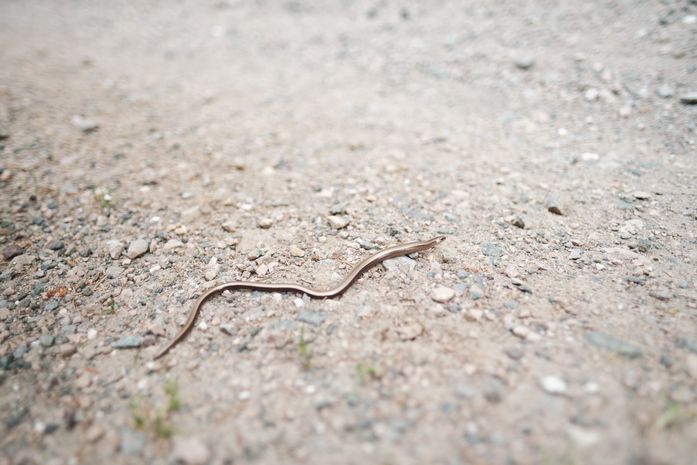
Generally, snakes are not aggressive, and they will try and avoid trouble with humans. They only get defensive when they feel threatened and might bite. Therefore, you need information on how to avoid snakes, react when you meet on the trails, and what to do when they bite.
You also need to understand the different types of snakes you are likely to encounter and whether they are venomous.
Venomous snakes that you are more likely to encounter
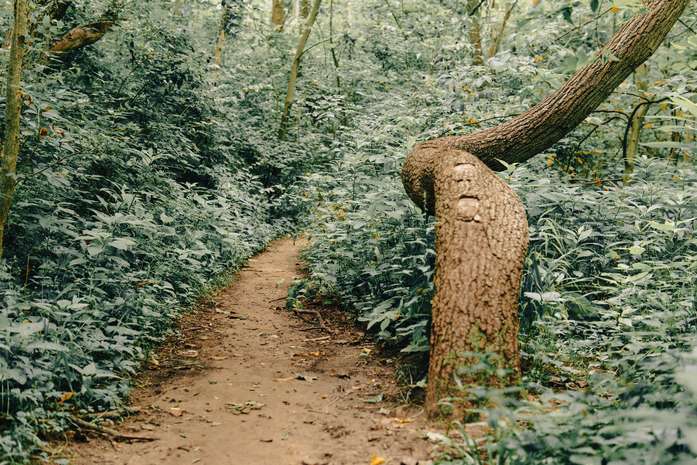
Most snakes you face are not harmful and will only bite as a defense mechanism. The bite is also not toxic since they are non-venomous. However, we bring to your attention four types of snakes that you have to be extra careful with because their bite is lethal and can be lethal if it is not treated in good time.
A snake bite is one of the injuries that you can get while hiking (check more here). The venomous snakes that you will most likely come across on the trails include the following:
Rattlesnakes
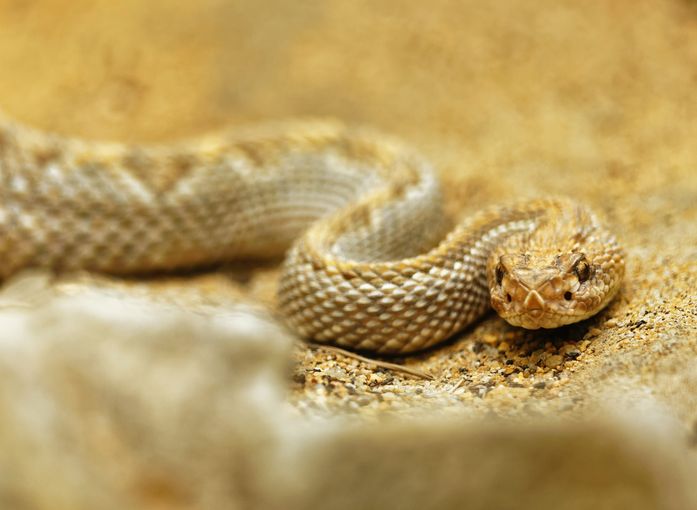
In most cases, you will come across rattlesnakes in the deserts, but that is not to say you might not spot one in forest areas. As the name suggests, rattlesnakes rattle when they feel threatened. They spend most of their days hidden under rocks meaning there is a very low likelihood that they will cross your path unless you go looking for them.
Water moccasins
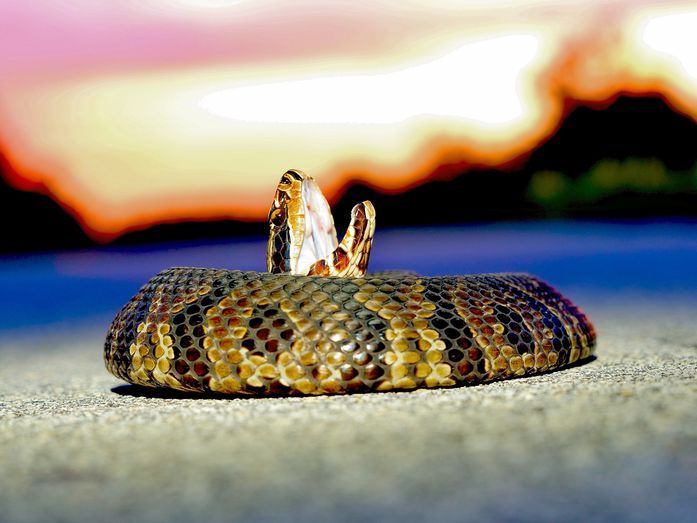
Water moccasins, also commonly known as cottonmouth snakes, are the most aggressive snakes you will encounter. You will find them near water sources, and they will only attack you if you get too close.
You should be careful with water moccasins because they will pursue you if they feel you are a threat. They usually send a warning beforehand by releasing a pungent smell. Copperhead snakes
Coral snakes
Watch the most venomous snake here:
Coral snakes are not aggressive, but once they attack, they are lethal. There is a meager chance that you will come across them since they are reclusive and prefer to stay underneath logs and inside holes. If you stay away from rotting logs, you will never encounter coral snakes on your hiking journey.
If by any chance you get bitten by a coral snake, call for emergency help. Because of how rare they are, you might not be able to recognize them. Therefore, we recommend that you avoid snakes on the hiking trails.
Copperhead snakes

Facts about the copperhead snake:
Copper heads are the most miniature aggressive snakes you will likely encounter on the hiking trail. They do not flee or pursue when threatened. They freeze, so you can easily step on one and get bitten. Their venom is also the least lethal but can be harmful if you do not treat it promptly. They also camouflage with their habitat, and you easily miss them.
How to stay safe from venomous snakes while hiking
1. Find out the probability of coming across a snake on the trail.
This step is essential when you are planning for the hike. It is equally vital as checking the weather forecast and shopping for supplies. It would help if you researched the animals you will most likely come across on your trail, including snakes.
Snakes thrive better in some habitats, and you need to find out whether the trail you are going to is home to the venomous type. This information will help you prepare well for any eventuality. Please get to know the kind you might find and how to behave around them.
The Internet is a good source of information, but you need more to help you identify venomous snake species. Get accurate information from the park rangers before hiking, including areas where you cannot veer off the trail.
2. Understand their behavior in different seasons

Once you know where you are more likely to encounter venomous snakes, you must understand how they behave. Most snakes are ectoderms meaning they rely on external sources of warmth. This means there is almost zero chance of bumping into a snake when hiking in winter.
This understanding will also help you know that you will find a snake stretched out on the path in the early morning or evening, getting some sunshine. Summer is the most notorious for venomous snakes.
During the day, when the sun is scorching hot, you should avoid resting on rocks because there is a chance that a snake is taking shelter underneath it. Also, avoid peeping into tree canopies; you might intrude on someone’s resting place, and they might not take it nicely.
Be careful where you rest your hands and feet when taking a break. Also, look for signage since the park’s management always marks the areas where venomous snakes highly infest to keep hikers safe.
3. What will you do when you come across a snake?
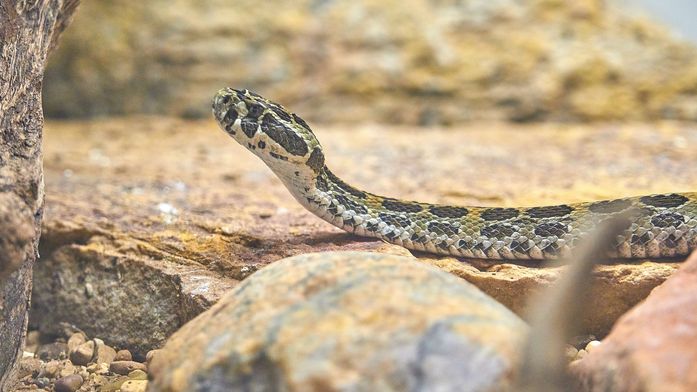
When you encounter a venomous snake while hiking, you have probably wandered too far away from the trail. Snakes naturally avoid confrontations with humans.
You are on the trail minding your business and happen to come across a venomous snake. The first you should do is to stay calm and immediately start backing away. Experts suggest you stomp while moving back since the vibrations will inform the snake that you are moving farther. All this while, keep an eye on the snake to ensure it is not pursuing you.
Watch its behavior from a distance until it looks calm. It will likely start moving away from the trail towards the forest. You can continue with your journey once it is entirely out of sight, cautiously, though, since it might not have moved far. If there is an alternative route, we advise you to go that way.
When the course is clear, move slowly until you cross the area where you have seen the snake. You do not want to startle it, especially if it is an aggressive type that may attack.
4. What if you get bitten?
Accidents happen even to the most prepared. You can follow all these steps and still find yourself on the wrong side. When a snake bites, the first thing is to avoid panicking. Realize that most of the snakes found in parks are non-venomous but don’t slow down your response.
Try to identify the species if you can see the snake since some will bite and slither away. If you can determine the snake to be non-venomous, clean the area to prevent further infections. Alcohol wipes from your first aid kit will come in handy.
We have heard that the first thing to do after a snake bite makes a tourniquet and suck the venom. These are myths that will only worsen the problem.
Venomous snakes can be aggressive, so the first step should be backing away to avoid another bite. Try and get someone to help you get to the nearest hospital and hope they will have the right anti-venom. Stay calm to slow down the rate at which the poison is moving through your body. Most venom is not fatal instantly, and you will have enough time to find the proper medical support.
5. Enjoy the experience
The thought of encountering a snake can be chilling and might discourage you from heading to the trails. This should not be the case, as the numbers of snake bites that have ever been reported are pretty low.
Take time and enjoy nature as you hike on the trails. Do not be crippled by fear since this will only make you anticipate danger. Maintain a safe distance and follow instructions from the park rangers to stay safe.
Some snakes have beautiful colorful skin, which you can take a photo of for your gallery. Hiking is all about enjoying the adventure.
Conclusion
Whether they hiss, rattle or huff, always remember that you are more prominent and intelligent than the snakes. Most snakes will try to protect themselves from you, and if you stop being a threat, they move on with their lives. Do not be aggressive with snakes. Don’t try to shush them away or hit them with an object.
It is common to encounter Venomous snakes while Hiking and this should not deter you from going for more adventures.
We hope this information is helpful and you will be able to share the space with wildlife in the forests. We hope to interact with you in the comment section.
Show your appreciation by liking, sharing, and subscribing!
